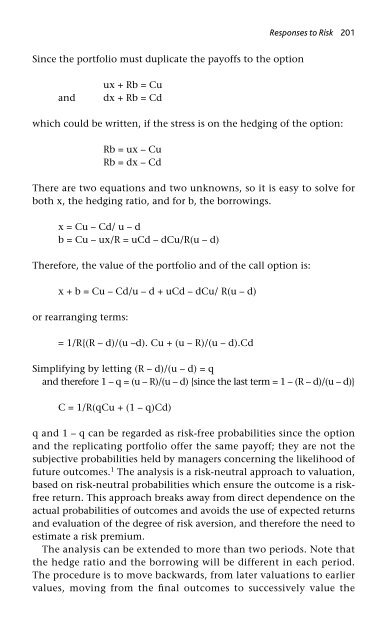Risk and Foreign Direct Investment - Index of
Risk and Foreign Direct Investment - Index of
Risk and Foreign Direct Investment - Index of
Create successful ePaper yourself
Turn your PDF publications into a flip-book with our unique Google optimized e-Paper software.
Since the portfolio must duplicate the pay<strong>of</strong>fs to the option<br />
ux + Rb = Cu<br />
<strong>and</strong> dx + Rb = Cd<br />
which could be written, if the stress is on the hedging <strong>of</strong> the option:<br />
Rb = ux – Cu<br />
Rb = dx – Cd<br />
There are two equations <strong>and</strong> two unknowns, so it is easy to solve for<br />
both x, the hedging ratio, <strong>and</strong> for b, the borrowings.<br />
x = Cu – Cd/ u – d<br />
b = Cu – ux/R = uCd – dCu/R(u – d)<br />
Therefore, the value <strong>of</strong> the portfolio <strong>and</strong> <strong>of</strong> the call option is:<br />
x + b = Cu – Cd/u – d + uCd – dCu/ R(u – d)<br />
or rearranging terms:<br />
= 1/R{(R – d)/(u –d). Cu + (u – R)/(u – d).Cd<br />
Simplifying by letting (R – d)/(u – d) = q<br />
<strong>and</strong> therefore 1 – q = (u – R)/(u – d) {since the last term = 1 – (R – d)/(u – d)}<br />
C = 1/R(qCu + (1 – q)Cd)<br />
Responses to <strong>Risk</strong> 201<br />
q <strong>and</strong> 1 – q can be regarded as risk-free probabilities since the option<br />
<strong>and</strong> the replicating portfolio <strong>of</strong>fer the same pay<strong>of</strong>f; they are not the<br />
subjective probabilities held by managers concerning the likelihood <strong>of</strong><br />
future outcomes. 1 The analysis is a risk-neutral approach to valuation,<br />
based on risk-neutral probabilities which ensure the outcome is a riskfree<br />
return. This approach breaks away from direct dependence on the<br />
actual probabilities <strong>of</strong> outcomes <strong>and</strong> avoids the use <strong>of</strong> expected returns<br />
<strong>and</strong> evaluation <strong>of</strong> the degree <strong>of</strong> risk aversion, <strong>and</strong> therefore the need to<br />
estimate a risk premium.<br />
The analysis can be extended to more than two periods. Note that<br />
the hedge ratio <strong>and</strong> the borrowing will be different in each period.<br />
The procedure is to move backwards, from later valuations to earlier<br />
values, moving from the final outcomes to successively value the




